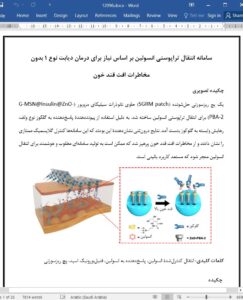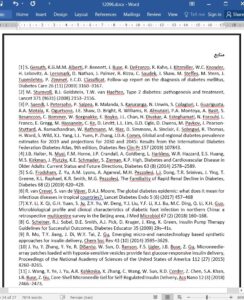Abstract
Diabetes is a metabolic disease that is affecting an ever-increasing number of people worldwide, resulting in increased burdens on healthcare systems and societies. Constant monitoring of blood glucose levels is required to prevent serious or even deadly complications. One major challenge of diabetes management is the simple and timely administration of insulin to facilitate consistent blood glucose regulation and reduce the incidence of hypoglycemia. With this research, we construct an insulin delivery system, the delivery system is comprised of phenylboronic acid based fluorescent probes, which is used as glucose responsive linkers, mesoporous silica nanoparticles providing an insulin reservoir, and zinc oxide nanoparticles used as gate keepers. The system with glucose sensitive responsive linker exhibits controlled release of insulin under high glucose concentrations, providing prolonged blood glucose regulation and no risks of hypoglycemia. Furthermore, the system is combined with a hyaluronic-acid based microneedle patch, which exhibit efficient skin penetration for transdermal delivery. With our system, the nanoparticles provide outstanding in vivo glucose regulation when administrated by subcutaneous injection or via transdermal microneedle patch. We anticipate that our biocompatible smart glucose responsive microneedle patch (SGRM patch) will facilitate the development of clinically useful systems.
1. Introduction
Diabetes mellitus is a chronic metabolic disorder characterized by high blood glucose levels (BGLs), and is caused by insufficient insulin supply or insulin resistance, and currently affects millions of people worldwide [1,2]. Importantly, the number of diabetic patients worldwide is expected to soar from 425 million in 2019 to 700 million by 2045 [3]. People with diabetes have a higher risk of developing life-threatening complications, including cardiovascular disorders, renal diseases, foot infectious, and can even lead to amputation [4–7]. However, postprandial injection of insulin using a syringe is painful and inconvenient for patients with type 1 diabetes and advanced type 2 diabetes, which leads to poor treatment compliance. In addition, costly insulin pumps need periodic replacement, which may increase the risk of infection [8].
4. Conclusions
We have successfully constructed an insulin delivery system GMSN@Insulin@ZnO-PBA-2 for type 1 diabetic treatments. Wulfftype phenylboronic acid was firstly used as the glucose responsive linker in an insulin delivery system, achieving both prolonged BGLs regulation and avoided of hypoglycemia in vivo compared with other PBAs based insulin delivery systems [30,31,33–37]. The unique Wulff-type phenylboronic acid PBA-2 on ZnO-PBA-2 could forms stable boronic ester with diols on G-MSN under physiological condition, while the boronic ester was completely broken under high BGLs, thus the capping agent was detached from G-MSN and insulin was released from the pores. Furthermore, GMSN@Insulin@ZnO-PBA-2 was incorporated into hyaluronic-acid based dissolving microneedle patch to reduce the pain of injection and achieve convenient administration, which could result in the development of desirable smart insulin delivery system with the potential for clinical application. Further studies would focus on the long-term biosafety and biodistribution of GMSN@Insulin@ZnO-PBA-2.











